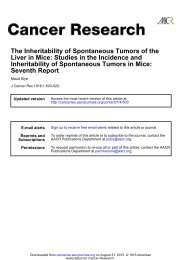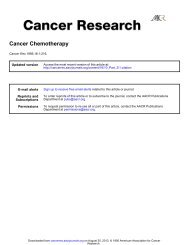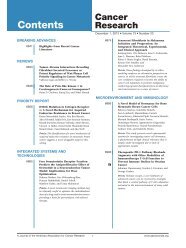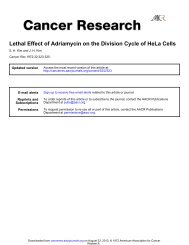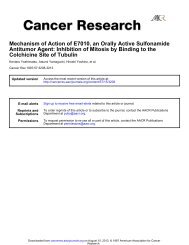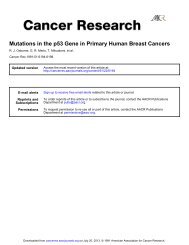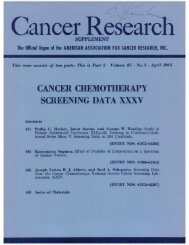XANTHOMA OF THE BREAST In a series of nine hundred (circa ...
XANTHOMA OF THE BREAST In a series of nine hundred (circa ...
XANTHOMA OF THE BREAST In a series of nine hundred (circa ...
You also want an ePaper? Increase the reach of your titles
YUMPU automatically turns print PDFs into web optimized ePapers that Google loves.
Downloaded from cancerres.aacrjournals.org on December 28, 2013. © 1932<br />
American Association for Cancer Research.<br />
1096 CUSHMAN D. HAAGENSEN<br />
degeneration in an inflammatory process in the breast, is chosen<br />
from many instances <strong>of</strong> this type <strong>of</strong> lesion in the records <strong>of</strong> the<br />
Memorial Hospital.<br />
CASE 5: L. G., a single white woman, aged 32, was admitted to the<br />
Memorial Hospital on Dec. 19, 1929.<br />
Past History: The patient had never been pregnant.<br />
Present Illness: Two months previously she had noticed slight tenderness<br />
<strong>of</strong> the right breast. A week later definite redness and elevation <strong>of</strong><br />
the skin were observed over the tender area. The patient had no temperature<br />
but. began to feel weak. The breast became distinctly painful.<br />
Physical Examination: <strong>In</strong> the upper outer quadrant <strong>of</strong> the right breast<br />
there was a firm, somewhat cystic, indurated mass measuring 5 x 5 em.<br />
The overlying skin was reddened but not adherent to the mass. There<br />
was no skin or nipple retraction. The tumor was tender. <strong>In</strong> the right<br />
axilla there were a few enlarged lymph nodes. Examination <strong>of</strong> the urine<br />
was negative.<br />
Treatment: A diagnosis <strong>of</strong> carcinoma was made, and on Dec. 20, 1929,<br />
a radical mastectomy was done by Dr. Frank Adair.<br />
Gross Diagnosis (Pathologic Specimen No. B 9365): The breast on<br />
section shows a central, s<strong>of</strong>tened, necrotic area measuring 3 x 5 em.,<br />
which is filled with blood and fibrin. The area is circumscribed by a wall<br />
<strong>of</strong> thickened fibrous tissue.<br />
Microscopic Diagnosis: The structure is that <strong>of</strong> an old breast abscess<br />
(Figs. 13 and 14). Plasma cells and lymphocytes predominate. Many<br />
polynuclear leukocytes are seen. Scattered throughout are areas where<br />
large foam cells, with their characteristic small, dark nuclei and foamy<br />
cytoplasm, predominate.<br />
Diagnosis: Chronic breast abscess with secondary xanthomatous degeneration.<br />
(3) Secondary Xanthomatous Degeneration in Traumatic Fat<br />
Necrosis in the Breast: Trauma to the breast may, in unusual cases,<br />
produce a localized area <strong>of</strong> necrosis in the fat which makes up so<br />
prominent a part <strong>of</strong> the organ. <strong>In</strong> the early stage <strong>of</strong> necrosis such<br />
a lesion consists <strong>of</strong> a small cavity filled with fatty debris. <strong>In</strong> the<br />
later stage <strong>of</strong> repair the microscopic picture is quite different, suggesting<br />
a granulomatous process in fat. The destroyed fat globules<br />
have been replaced by fibrous tissue containing occasional<br />
lymphocytes and numerous multinucleated giant cells. Foam cells<br />
are a prominent feature. <strong>In</strong> some areas they surround the fat<br />
globules in such a way as to suggest alveoli. They have the<br />
characteristic structure <strong>of</strong> foam or xanthoma cells- a small, dark<br />
nucleus lying in a proportionately large, foamy cytoplasm. The<br />
appearance <strong>of</strong> these cells during the repair stage <strong>of</strong> fat necrosis



